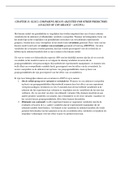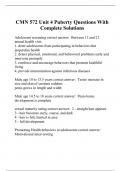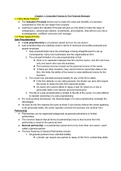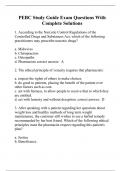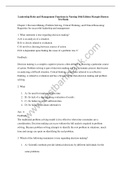Introduction
Types of securities. The types of securities are common stock, preferred stock, and debt (bonds). There are short-
term bonds (<10years) which are called notes, and long-term bonds, called indentures.
The capital market. In the capital market there are primary transactions (first time going public) and secondary
transaction (resale of the securities).
Investment decisions. The present value determines how much you are going to pay for the securities.
Information to investors. The goal of securities regulation is to reduce outside investors’ informational disadvantage.
Companies will disclose information voluntarily to avoid the discount investors will give if they do not get
information. However, there is no disclosure if (1) no plan on going public, (2) antifraud liability is not credible, (3)
managers have an incentive for insider trading and suboptimal information. A mandatory disclosure system is
preferred because (1) comparing advantages between firms, (2) less agency costs, (3) positive externalities to
competitors of providing firm-specific information, (4) no duplicative research needed. ▬ The Efficient capital
market hypothesis: weak version, i.e. all past prices are incorporated in the current market price of that security,
semi-strong, i.e. all relevant publicly available information, and strong, i.e. all information. The presumption is the
semi-strong version, “fraud-on-the-market” theory.
Regulation. The Securities Exchange Act protects investors through disclosure and antifraud liability, the Securities
Act focuses on the primary market transaction with the registration statement and prospectus.
1
, Materiality
Intro. Materiality: is the information important enough?
TSC Industries: Information is material if there is a substantial likelihood that the disclosure would have been viewed
by the reasonable investor as having significantly altered the total mix of information made available.
Forward-looking information. Basic Inc. v. Levinson: It is not enough that a statement is false or incomplete, if the
misrepresented fact is not material. Board resolutions and actual negotiations can be material. Materiality depends
on the significance the reasonable investor would place on the withheld or misrepresented information. – There is
a Probability x magnitude test.
Objectives tests of materiality. The magnitude of a misstatement is the beginning of an analysis of materiality (the
rule of thumb: probability [historic facts: 100%] x magnitude is less than 5% of the earnings of a company > not
material). Besides this quantitative factor, qualitative factors should be taken into account for assessing the
materiality.
Litwin v. Blackstone Group: Although the quantitative threshold of 5% was not reached, because of the qualitative
factors (segment that plays a significant role, reasonably likely change in earnings) the omissions were material.
Re Merck & Co: Determination of when the stock market learns about the undisclosed fraud or omission > The
materiality of disclosed information can be measured post hoc: is there an adverse effect to the stock price from
the disclosure in the period immediately following disclosure?
Matrixx Initiatives: The mere existence of adverse events does not meet the materiality standard, something more
is needed. However, this ‘something more’ doesn’t need to be statistical significance per se, but can also come from
the source and content of the reports.
The “total mix”. The “truth on the market defense” is one variation on the “total mix” doctrine. Another variation is
the “bespeaks caution” doctrine, where forward-looking statements are rendered immaterial if they are
accompanied by disclosure of risks.
Longman v. Food Lion: “truth on the market defense” > A false material statement, a fact is material if there is a
substantial likelihood that a reasonable purchaser or seller (1) would consider the fact important in deciding whether
to buy or sell the security or (2) would have viewed the total mix of information made available to be significantly
altered by disclosure of the fact. In this case, the market had already the information about the labor violations, and
had the opportunity to evaluate these claims and reflect the risk in the market price for the stock.
Management integrity. Full disclosure makes management more accountable to shareholders.
Franchard Corporation: The activities of the CEO should be disclosed, particularly because of his strained financial
position, conflicts of interest, and the possibility of a change of control of the CEO as operator. So disclosure of facts
that can make management uncomfortable.
SEC v. Fehn: Disclosure may also be required if a civil lawsuit or criminal investigation reflects on management
integrity.
2
, Definition of ‘security’
Intro. If something is a security, the securities laws (registration, prospectus, gun-jumping rules) apply.
Investment contract. This is the “catch-all” provision of the definition of a security. The Howey-test determines
whether an instrument is a security.
SEC v. Howey: An investment contract is a contract, transaction or scheme where (1) a person invests his money, (2)
in a common enterprise and (3) is led to expect profits (4) solely from the efforts of the promoter or third party. If
there is an investment contract, it is a security, and securities laws apply.
#1: What is an investment? Daniel: An investor chooses to give up his money in return for a separable financial
interest with the characteristics of a security. If a pension fund is mandatory without contributions of the employee,
there is no investment. ▬ Marine Bank: Because there is an alternative regulatory regime that fully protects investors,
it was deemed no security.
#2: What is commonality? SEC v. SG: Horizontal commonality involves the pooling of assets from multiple investors,
where the investors share in the profits.
#3: What is expectation of profits? Forman: Profits are capital appreciation or a participation in earnings. The
purchase of a commodity for personal consumption is not enough to expect profits. (The label “stock” is not
sufficient to be stock, it needs the significant characteristics of stock: right to receive dividends, ability to be pledged,
conferring of voting rights, capacity to appreciate in value.)
Is a fixed return also participation in earnings? Edwards: There is no reason to distinguish between promises of fixed
returns and promises of variable returns. The return is expected to come solely from the efforts of others.
What if there is an investment in a mixture of consumption (or charitable giving) and financial return? Warfield:
According to the promotional materials the investment component of the annuity was evident, i.e. the periodic
payments and tax benefits could deliver a return on the initial payment.
#4: What is solely from the efforts of others? With a partnership > Merchant Capital: Limited partnership interests
are presumed to be securities unless the limited partners exercise effective control over the enterprise. A general
partnership interest is presumed not to be an investment contract because a GP typically takes an active part in
managing the business. However, it will be an investment contract if the GP has little ability to control the profitability
of the investment: little power, inexperienced, or dependent on an unique managing ability of the promoter.
(Williamson v. Tucker). Nominal involvement (i.e. very small) of investors does not nullify the status of investment
contract.
What if the investor and the promoter both exert nominal effort? Mutual Benefits Corp: The investors’ expectations
of profits relied heavily on the pre-and post-payment efforts of the promotors in making investments profitable, so
the selection of the assets going into the pool (i.e. those efforts were the significant ones, not the efforts of the
investor), i.e. investment contract. ▬ With a franchise: typically the franchisee’s efforts are the significant ones in
determining whether the business will be a success. The economic reality will be investigated.
Stock. The relation between the Howey test for investment contracts and other items in the list of instruments
defined as securities.
Landreth: In Forman was established that stock needs to have the characteristics of stock. In this case these
characteristics are present, so there is no need to see if it fits in the Howey test for investment contracts.
Note. Only a fraction of all notes are securities.
Reves v. Ernst & Young: Notes are used in a variety of settings, not all of which involve investments (in contrast to
common stock). The Howey test should not be applied to notes, because it is a mechanism for determining whether
an instrument is an “investment contract”. Even if a note is not an investment contract, it could still be a note. For
notes we use the family resemblance test/ investment versus commercial approach (these are similar). Test: (1) what
is the motivation to buy the note, e.g. interested in the profit, or commercial or consumer purpose, (2) plan of
distribution, e.g. sold to a broad segment of the public, (3) reasonable expectations of the investing public, and (4)
the existence of another regulatory scheme. This Reves test for notes is a multi-factor test, so not all factors have to
be satisfied to be deemed a security. – If the maturity of a note is less than nine months, there is an exception.
Securitization. Securitization is the pooling of non-liquid assets and the sale of interests in the returns from this
pool. The issuance of debt securities backed by the assets of the securitization pool (i.e. asset-backed security)
almost always meet the Reves test. The benefits of securitization are liquidity and diversification.
3



